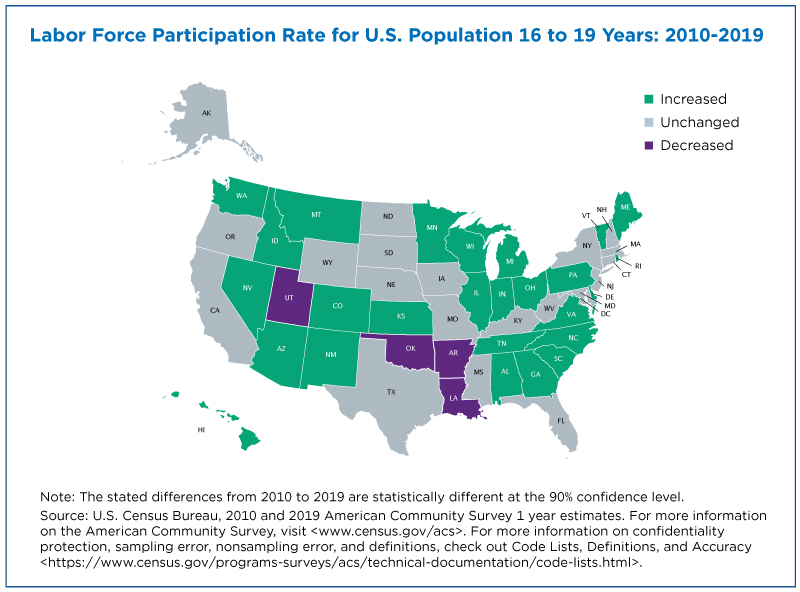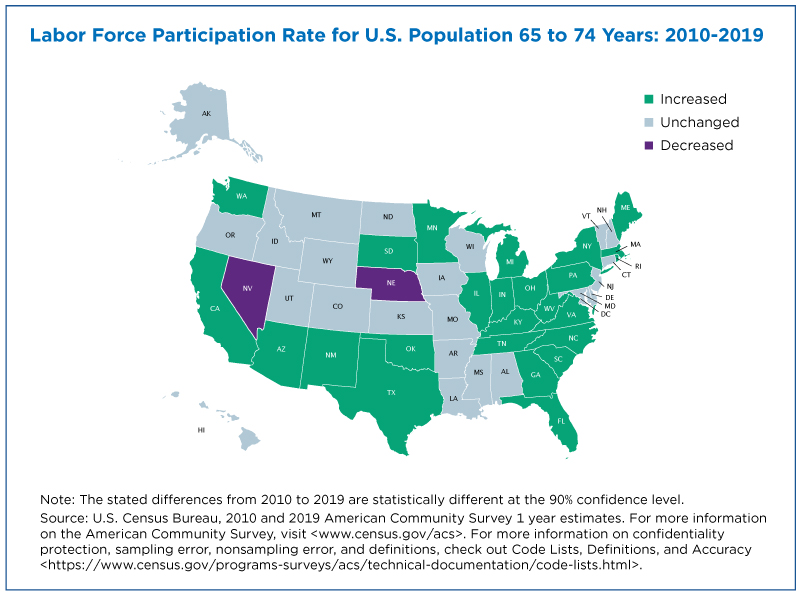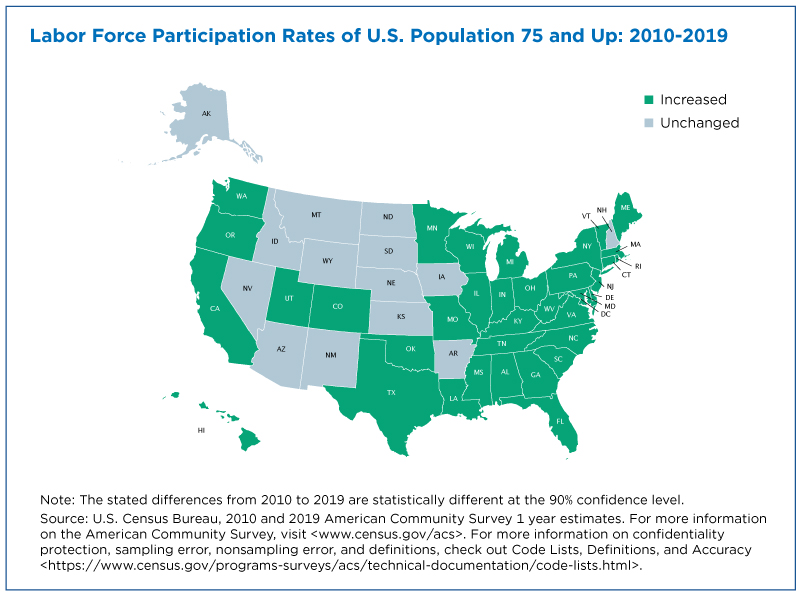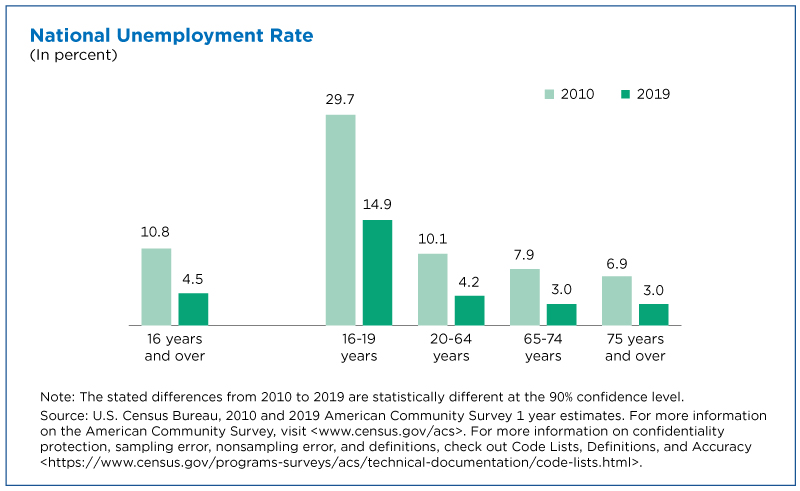Aging Boomers Solve a Labor Market Puzzle
The last decade was free of recessions and from the opening bell in January 2010 to the closing bell in December 2019, the Dow Jones Industrial Average and S&P 500 soared 173.60% and 189.35%, respectively. The Gross Domestic Product increased from $14.992 trillion to $21.433 trillion.
Yet, during that same period, the labor force participation rate actually declined.
The solution to this labor market puzzle: rise in the percentage of the population ages 65 and over.
So, how could it drop when the economy was booming and labor force participation rates among the working-age population grew in every age category?
The solution to this labor market puzzle: rise in the percentage of the population ages 65 and over.
The oldest baby boomers were 64 in 2010 and 73 in 2019. As they aged, a large segment of the population shifted into 65 and older age groups.
Because older Americans are less likely than younger ones to be in the labor force, this demographic shift reduced the overall labor force participation rate.
Labor force participation includes working-age adults who are either working or looking for work.
This article uses estimates from the 2010 and 2019 American Community Survey (ACS) 1-year.
Labor Force Participation by Age
The national labor force participation rate for the total population ages 16 and over decreased from 64.4% in 2010 to 63.6% in 2019.
Despite the overall dip, the labor force participation rate went up across all age groups from 2010 to 2019:
- Ages 16 to 19: 37.7% to 39.9%.
- Ages 20 to 64: 77.5% to 78.3%.
- Ages 65 to 74: 24.8% to 26.8%.
- Ages 75 and older: 5.7% to 7.2%.
This apparent discrepancy in the rates can be explained by the sea change in the age distribution of the U.S. population.
Effect of Aging on Labor Force
From 2010-2019, as the U.S. economy improved, the percentage of the population ages 65 and older grew nationally (from 13.1% to 16.5%) and in all 50 states and the District of Columbia.
These increases affected both the national and state labor force characteristics.
The labor force participation rates of people ages 65 to 74 and 75 years and older were lower than for the population ages 16 to 19 and 20 to 64 in 2010 and in 2019.
Even so, older Americans were still more likely to be in the labor force in 2019 than in 2010.
Labor Force Trends in States
This seemingly contradictory pattern of an overall decline in labor force participation but increases in every age group was evident at the state level as well.
Only one state (Utah) and the District of Columbia experienced increases in their labor force participation rates for the total working-age population ages 16 and older while 38 states experienced decreases.
However, just as it played out nationally, labor force participation rates went up in most states in every age group from 2010 to 2019:
- Ages 16 to 19, up in 26 states and D.C., and down in four.
- Ages 20 to 64, up in 26 states and D.C., and down in three.
- Ages 65 to 74, up in 25 states and down in two.
- Ages 75 and older, up in 36 states and down in none.
Aging and Unemployment
People without jobs searching and available for work are considered unemployed.
Unemployment rates trended downward overall from 10.8% in 2010 to 4.5% in 2019. They also declined for each age cohort:
- Ages 16 to 19, from 29.7% to 14.9%.
- Ages 20 to 64, 10.1% to 4.2%.
- Ages 65 to 74, 7.9% to 3.0%.
- Ages 75 and older, 6.9% to 3.0%.
The unemployment rates of the population ages 65 to 74 and 75 and older were lower than the unemployment rates of the population ages 16 to 19 and 20 to 64, in both 2010 and 2019.
As the nation and labor force aged, older Americans’ lower unemployment rates and continued presence in the labor force drove down the overall unemployment rate.
This effect was compounded by the improving labor market that reduced unemployment rates for all age groups between 2010 and 2019.
Aging Out, Not Dropping Out
These demographic subtleties matter because labor force participation and unemployment rates are key measures of economic health.
Conventional wisdom about falling labor force participation rates is that discouraged workers are dropping out of the labor force. But that conclusion can be misleading, especially when the country is experiencing significant demographic shifts, such as changes in the age distribution of the U.S. population the last decade.
As a result, demographic changes rather than economic and labor market conditions may be the driving factor behind labor force participation and unemployment rates.
David Howard is a survey statistician in the Census Bureau’s Social, Economic and Housing Statistics Division.
Subscribe
Our email newsletter is sent out on the day we publish a story. Get an alert directly in your inbox to read, share and blog about our newest stories.
Contact our Public Information Office for media inquiries or interviews.
-
America Counts StoryMoms, Work and the PandemicMarch 03, 2021New data show that there were 1.4 million more mothers not actively working for pay in January compared to pre-pandemic levels.
-
America Counts StoryWhat Is Ahead for the Nation’s Aging Workforce?April 24, 2018The percentage of employed older people increased during the past two decades and these workers are earning more on average than older workers in the past.
-
America Counts StoryWhen Army Heroes Return to the Civilian Labor MarketFebruary 01, 2021Veterans Employment Outcomes, a new Census Bureau experimental product, shows how U.S. Army veterans fare in the job market after discharge.
-
Business and EconomyWhat Is the Nonemployer Marine Economy?April 09, 2025Thirty states had nonemployer businesses in marine economy sectors, including six states in the Midwest with receipts totaling nearly $11 billion in 2022.
-
Business and EconomyEconomic Census Geographic Area Statistics Data Now AvailableApril 07, 2025A new data visualization based on the 2022 Economic Census shows the changing business landscape of 19 economic sectors across the United States.
-
Income and PovertyWhat Sources of Income Do People Rely On?April 02, 2025A new interactive data tool shows income sources for hundreds of demographic and economic characteristic combinations.
-
Business and EconomyBig Improvements to the Annual Integrated Economic Survey (AIES)March 26, 2025The Census Bureau is making several changes and enhancements to capture 2024 economic data based on feedback from last year’s survey.












